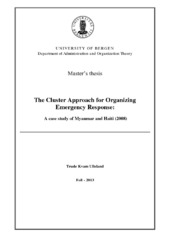The Cluster Approach for Organizing Emergency Response: A case study of Myanmar and Haiti (2008)
Master thesis
Permanent lenke
https://hdl.handle.net/1956/7763Utgivelsesdato
2013-12-13Metadata
Vis full innførselSamlinger
- Department of Government [473]
Sammendrag
This study examines the formal organization of the cluster approach and how it is in practice in the after math of natural disasters. The cyclone Nargis that hit Myanmar in 2008 and the tropical storms and hurricane season in Haiti in 2008 are used as examples for how the cluster approach has been applied in practice. The empirical data is described and structured through four key variables: specialization, coordination, leadership and accountability. To understand and describe the cluster approach formal organization and how it is implemented a multi-level governance theoretical framework is used. In order to examine and explain possible variations of the implementation from the intended structure an instrumental and institutional perspective is applied. The findings in this study are based on cluster approach guidelines, cluster approach evaluation phase II, supplementary interviews and on observation. The case studies of Myanmar and Haiti are set in two different institutional systems and regimes. The examination of the cluster approach indicates that the institutional context of the cluster approach implementation matters.
